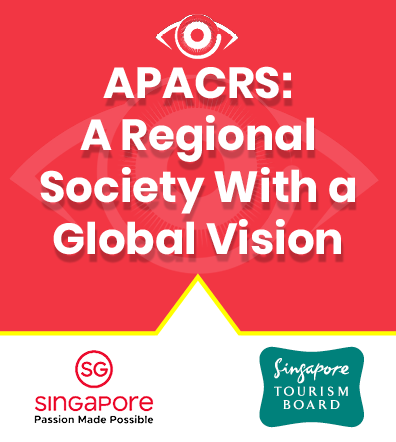Eyeworld Weekly Update |
Volume 21, Number 29 |
19 August 2016 |
- Vascular growth factors linked to proptosis
- Flexivue Microlens showed "excellent outcomes" in Korean patients Flexivue Microlens showed "excellent outcomes" in Korean patients
- UCSD: Lanosterol may be promising topical cataract treatment
- NEI grants $1 million to UAB researcher to study telemedicine in glaucoma
Vascular growth factors linked to proptosis
Researchers at the Schepens Eye Research Institute of Massachusetts Eye and Ear (Boston) have found vascular growth factors causing an abnormal proliferation of blood vessels as well as the rare formation of lymphatic vessels that may contribute to the dangerous swelling and inflammation that occurs in the orbits of patients with proptosis, the institute said in a news release. The researchers noted a "proliferation of blood vessels" and in some acute cases, lymphatic vessels form where there normally are none. The findings suggest it "might be possible" to treat the inflammatory aspects of the disorder by preventing blood vessel formation and enhancing fluid drainage. With the hope of finding markers that may enable more targeted therapy, the researchers studied samples obtained from 15 patients with thyroid eye disease undergoing orbital decompression. In samples from the acute, inflammatory stage of the disease, they found that both rare lymphatic vessels and robust blood vessels had formed. While more studies are needed, the proliferation of leaky blood vessels not only offers an underlying mechanism for the swelling, but also offers the potential to be controlled with local administration of angiogenesis inhibitors (such as anti-VEGF). Moreover, by determining the mechanisms underlying lymphatic vessel formation in the acute stage of the disease, the creation of functional lymphatic vessels may be utilized as a therapeutic option to better drain fluid from the orbit.
Flexivue Microlens showed "excellent outcomes" in Korean patients Flexivue Microlens showed "excellent outcomes" in Korean patients
The 1-year results in 14 patients implanted with the Flexivue Microlens (Presbia, Dublin) found subjects gained an average of five lines of near vision, according to the company. Results of the study were presented in Seoul by Lee Jong Ho, MD, who added his results were "highly consistent" with prior clinical studies completed in Europe.
UCSD: Lanosterol may be promising topical cataract treatment
Researchers from the University of California, San Diego (UCSD) have developed an eye drop based on the naturally occurring steroid lanosterol that has significantly decreased preformed protein aggregates both in vitro and in cell transfection experiments in animal studies. These studies also show lanosterol "could reduce cataract severity and increase transparency in dissected rabbit cataractous lenses in vitro and cataract surgery in vivo in dogs," the university said in a press release. Human trials are expected to begin within a year, the university said.
NEI grants $1 million to UAB researcher to study telemedicine in glaucoma
Lindsey Rhodes, MD, has received a $1 million National Eye Institute (NEI) grant to study new care delivery models such as telemedicine to treat glaucoma, the University of Alabama at Birmingham said in a news release. Dr. Rhodes said "it is essential to develop novel health care models, utilizing telemedicine, to improve the ability of routine eye exams to detect glaucoma at an earlier stage, and to provide a platform to manage this disease in community-based clinics so further vision loss is prevented."
RESEARCH BRIEFS
There is a possibility of bacterial biofilm formation on the optic surface of IOLs in normal eyes after long-term uncomplicated cataract surgery even in the absence of clinical or subclinical symptoms, according to Paloma Mazoteras and colleagues. In an experimental lab investigation, the researchers evaluated 69 eyes donated for transplantation that had previously undergone cataract surgery with posterior chamber IOL implantation and that had no recorded clinical history of postoperative inflammation. Isolated or aggregated cocci were probable in 18.8% of IOL optic surfaces (n=13) studied by scanning electron microscopy, suggesting the presence of bacterial biofilm. In three intraocular fluid samples for IOLs with biofilm, they identified 16S rDNA by polymerase chain reaction and sequencing. No microbial contamination was found in intraocular fluids by conventional microbiological methods. The study is published in the American Journal of Ophthalmology. The addition of bromfenac to topical steroids after cataract surgery in eyes with pseudoexfoliation syndrome (PXF) was associated with greater reductions in inflammation than steroids alone, according to Marco Coassin, MD, and colleagues. They randomized 62 patients with cataract and clinical signs of PXF to either dexamethasone 0.1% and tobramycin 0.3% ophthalmic solution (Group 1) or with the adjunct of bromfenac ophthalmic solution 0.09% (Group 2). All patients were examined on the day of surgery (baseline) and postoperatively at 1, 3, 7, and 30 days. Postoperatively, the mean flare was 31% lower in Group 2 than in Group 1 at 3 days (11.92 ±8.14 ph/msec vs. 17.13±9.03 ph/msec; P=.025) and 43% lower at 7 days (10.77±6.17 ph/msec vs. 18.72±12.37 ph/msec; P=.003). There were no significant differences in postoperative visual acuity, symptoms, or ocular pain between groups. The incidence of intraretinal cysts was higher in Group 1 (n=4) than in Group 2 (n=0). The study is published in the Journal of Cataract & Refractive Surgery. Implantation of the Stegmann Canal Expander (Ophthalmos, Schaffhausen, Switzerland) in circumferential viscocanalostomy (canaloplasty) lowered intraocular pressure (IOP) significantly in primary open-angle glaucoma (POAG) without complications related to the device in this 1-year observation period, according to a study in the Journal of Glaucoma. M.C. Grieshaber and colleagues prospectively evaluated 22 eyes (22 patients) who underwent primary viscocanalostomy and implantation of the Stegmann Canal Expander (a flexible, fenestrated hollow implant of 9 mm in length) into Schlemm's canal and who then had a follow-up time of at least 1 year. Schlemm's canal was unroofed ab externo, and dilated with viscoelastic material and microcatheter. One expander was implanted into either side of the surgically created ostium to keep Schlemm's canal permanently open. Laser goniopuncture of the trabeculo-Descemet membrane window was performed if postoperative IOP exceeded 16 mm Hg. The mean IOP dropped from 27.1±5.3 mm Hg preoperatively to 13.6±1.6 mm Hg at 6 months, 13.0±1.5 mm Hg at 9 months, and 13.1±2.2 mm Hg at 12 months (P<0.001). The complete success rates for an IOP ≤21, ≤18, and ≤16 mm Hg combined with a 30% IOP reduction were 91% each at 6 months, and 86%, 82%, and 82% at 12 months, respectively. The success rate of an IOP ≤16 mm Hg without medications did not depend on age, preoperative IOP, and mean visual defect. Laser goniopuncture was performed on two eyes (9%) 4.1 months postoperatively; the mean IOP was 19.5 mm Hg before and 13.6 mm Hg after goniopuncture. The number of medications dropped from 2.9±0.6 before surgery to 0.05±0.2 after surgery (P<0.001). The postoperative best corrected visual acuity at last visit was comparable to preoperative values.
 Licensed Publications |
Licensed through ASCRS American Society of Cataract and Refractive Surgery, 4000 Legato Road, Suite 700, Fairfax, VA 22033-4003, USA.
All rights reserved. The ideas and opinions expressed in EyeWorld Asia-Pacific Weekly News do not necessarily reflect those of the ASCRS�ASOA or APACRS. Mention of products or services does not constitute an endorsement by the ASCRS�ASOA or APACRS. Copyright 2008, EyeWorld News Service, a division of ASCRS Media. |




 EyeSustain Update
EyeSustain Update 2024 APACRS TRAVEL GRANT
2024 APACRS TRAVEL GRANT Digital EyeWorld
Digital EyeWorld VOL. 39 (2023), ISSUE 3
VOL. 39 (2023), ISSUE 3  Membership Information
Membership Information APACRS Principles of Preferred Practice
APACRS Principles of Preferred Practice